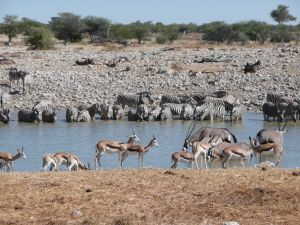DNA Barcoding: The International Barcode of Life
 Most people are familiar with DNA as used in forensics to identify the perpetrators of crimes from samples of blood, skin, saliva and hair, such as in the popular TV show CSI: Crime Scene Investigation. Now, scientists are envisioning using DNA and barcoding technology to instantly identify different species of animals and plants. This idea was proposed in 2003 by Paul Hebert, a researcher at the University of Guelph in Ontario, Canada. DNA barcoding, inspired by how products are identified by commercial bar codes, is revolutionizing the classification and identification of living things using the unique ordering of the four nucleic acids in the short strand of a DNA. Instead of black and white lines in product bar codes, DNA barcodes use nucleotides, the genetic letters that genes are composed of, to identify a species.
Most people are familiar with DNA as used in forensics to identify the perpetrators of crimes from samples of blood, skin, saliva and hair, such as in the popular TV show CSI: Crime Scene Investigation. Now, scientists are envisioning using DNA and barcoding technology to instantly identify different species of animals and plants. This idea was proposed in 2003 by Paul Hebert, a researcher at the University of Guelph in Ontario, Canada. DNA barcoding, inspired by how products are identified by commercial bar codes, is revolutionizing the classification and identification of living things using the unique ordering of the four nucleic acids in the short strand of a DNA. Instead of black and white lines in product bar codes, DNA barcodes use nucleotides, the genetic letters that genes are composed of, to identify a species. Carl Linnaeus pioneered modern taxonomy around 250 years ago. Traditionally, animals and plants are classified morphologically through their shape, size, color and behavior. Identification using morphological keys involved a step by step instruction of what to look for in an animal or plant. In recent decades, scientists have begun taking advantage of the properties of DNA to classify animals and plants. DNA or deoxyribonucleic acid is a nucleic acid that contains genetic instructions and is found in all living things (except for RNA viruses).
But both of these methods take up an enormous amount of time and expertise. There are over 10 million species of animals and plants on Earth. Of these, only 2 million have been identified. The human brain only has the capacity to learn to identify a few thousand species. Using barcoding technology and a small portion of the DNA together greatly reduces the time and expertise needed to correctly identify a species.
The International Barcode of Life project (iBOL) is an initiative that strives to bring together the works of different genomics specialists, biodiversity scientists, technologists and ethicists from 25 nations into a comprehensive reference library that will be the basis for a DNA-based identification system for all living things. In the first five years of operation, from 2010 to 2015, IBOL will barcode 5,000,000 specimens from 500,000 species. Scientists are also envisioning a portable handheld electronic device, called the Life Barcoder, that connects to the Barcode of Life Database (BOLD).
DNA barcoding can identify the species from a small sample of tissue alone, helpful for specimens that are damaged or in an immature stage of development. DNA barcoding works for all stages of life of a species, from eggs, larvae, adults, to seeds, seedlings and flowers. DNA barcoding also removes ambiguity between species that look alike, identifying dangerous species that look similar to harmless ones.
There are many practical applications of DNA barcoding that affects our everyday life. DNA barcoding can identify undesirable plant and animal material in processed food and commercial products. DNA barcoding can also reduce food fraud, selling a food product labeled as a different species. DNA barcoding is also useful for ecosystem monitoring, forensics, conservation and control of invasive species and agricultural pests.
Related articles:
(Care to add your comments? Please log in or Sign Up - See the Footer Menu - Entry/Sign In, then Register).
{jcomments on}
